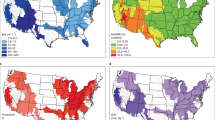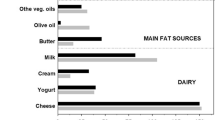Abstract
The water footprint concept has been recognized as being highly valuable for raising awareness of the large quantity of water resources required to produce the food we consume. We present, for three major European countries (the United Kingdom, France and Germany), a geographically detailed nationwide food-consumption-related water footprint, taking into account socio-economic factors of food consumption, for both existing and recommended diets (healthy diet with meat, healthy pescetarian diet and healthy vegetarian diet). Using socio-economic data, national food surveys and international food consumption and water footprint databases, we were able to refine national water footprint data to the smallest possible administrative boundaries within a country (reference period 2007–2011). We found geographical differences in water footprint values for existing diets as well as for the reduction in water footprints associated with a change to the recommended healthy diets. For all 43,786 analysed geographical entities, the water footprint decreases for a healthy diet containing meat (range 11–35%). Larger reductions are observed for the healthy pescetarian (range 33–55%) and healthy vegetarian (range 35–55%) diets. In other words, shifting to a healthy diet is not only good for human health, but also substantially reduces consumption of water resources, consistently for all geographical entities throughout the three countries. Our full results are available as a supplementary dataset. These data can be used at different governance levels in order to inform policies targeted to specific geographical entities.
This is a preview of subscription content, access via your institution
Access options
Access Nature and 54 other Nature Portfolio journals
Get Nature+, our best-value online-access subscription
$29.99 / 30 days
cancel any time
Subscribe to this journal
Receive 12 digital issues and online access to articles
$119.00 per year
only $9.92 per issue
Buy this article
- Purchase on Springer Link
- Instant access to full article PDF
Prices may be subject to local taxes which are calculated during checkout





Similar content being viewed by others
Data availability
The sources of the original data used for our analysis are listed in Methods. The data generated in this study are available in the Supplementary Information as an Excel file as well as a geodataset to link this Excel file. The geodatabase is based on original geographical boundaries, provided as open data51–53. When using the data generated in our study, please refer to this paper.
References
Vanham, D. Does the water footprint concept provide relevant information to address the water–food–energy–ecosystem nexus?. Ecosyst. Serv. 17, 298–307 (2016).
Hoekstra, A. Y. & Wiedmann, T. O. Humanity’s unsustainable environmental footprint. Science 344, 1114–1117 (2014).
Steffen, W. et al. Planetary boundaries: Guiding human development on a changing planet. Science 347, https://doi.org/10.1126/science.1259855 (2015).
Falkenmark, M. Meeting water requirements of an expanding world population. Philos. Trans. R. Soc. Lond. B, Biol. Sci. 352, 929–936 (1997).
Kummu, M. et al. The world’s road to water scarcity: shortage and stress in the 20th century and pathways towards sustainability. Sci. Rep. 6, 38495 (2016).
Gerten, D.et al. Towards a revised planetary boundary for consumptive freshwater use: role of environmental flow requirements. Curr. Opin. Environ. Sustain. 5, 551–558 (2013).
Dalin, C., Wada, Y., Kastner, T. & Puma, M. J. Groundwater depletion embedded in international food trade. Nature 543, 700 (2017).
Aldaya, M. M. Eating ourselves dry. Nature 543, 633 (2017).
Ripple, W. J.et al. World scientists’ warning to humanity: a second notice. Bioscience 67, 1026–1028 (2017).
Hoekstra, A. Y., & Mekonnen, M. M. The water footprint of humanity. Proc. Natl Acad. Sci., USA 109, 3232–3237 (2012).
Rockström, J. et al. Future water availability for global food production: the potential of green water for increasing resilience to global change. Water Resour. Res. 45, W00A12 (2009).
Liu, J. & Savenije, H. H. G. Food consumption patterns and their effect on water requirement in China. Hydrol. Earth Syst. Sci. 12, 887–898 (2008).
Vanham, D. The water footprint of Austria for different diets. Water Sci. Technol. 67, 824–830 (2013).
Vanham, D., Gawlik, B. M., & Bidoglio, G. Food consumption and related water resources in Nordic cities. Ecol. Indic. 74, 119–129 (2017).
Vanham, D., Gawlik, B. M. & Bidoglio, G. Cities as hotspots of indirect water consumption: the case study of Hong Kong. J. Hydrol. https://doi.org/10.1016/j.jhydrol.2017.12.004 (2018).
De Irala-Estévez, J. et al. A systematic review of socio-economic differences in food habits in Europe: consumption of fruit and vegetables. Eur. J. Clin. Nutr. 54, 706 (2000).
Bénetier, C. et al. Étude Individuelle Nationale des Consommations Alimentaires 2 (INCA 2) (2006–2007) (AFSSA – Agence Française de Sécurité Sanitaire des Aliments, Maisons-Alforts, 2009).
Heuer, T., Krems, C., Moon, K., Brombach, C., & Hoffmann, I. Food consumption of adults in Germany: results of the German National Nutrition Survey II based on diet history interviews. Br. J. Nutr. 113, 1603–1614 (2015).
Public Health England. National Diet and Nutrition Survey – Results from Years 1, 2, 3 and 4 (combined) of the Rolling Programme (2008/2009 –2011/2012) (London, UK, 2014).
Vanham, D., & Bidoglio, G. A review on the indicator water footprint for the EU28. Ecol. Ind. 26, 61–75 (2013).
Mekonnen, M. M. & Hoekstra, A. Y. The green, blue and grey water footprint of crops and derived crop products. Hydrol. Earth Syst. Sci. 15, 1577–1600 (2011).
Clarys, P. et al. Comparison of nutritional quality of the vegan, vegetarian, semi-vegetarian, pesco-vegetarian and omnivorous diet. Nutrients 6, 1318 (2014).
Vanham, D.et al. Water consumption related to different diets in Mediterranean cities. Sci. Total Environ. 573, 96–105 (2016).
Gilsing, A. M. J. et al. Vegetarianism, low meat consumption and the risk of colorectal cancer in a population based cohort study. Sci. Rep. 5, 13484 (2015).
Gawlik, B. M. et al. Urban Water Atlas for Europe (European Commission, Publication Office of the European Union, 2017).
UfM. Press release: UfM Ministers agree on new framework for an enhanced regional cooperation on Water in the Mediterranean http://ufmsecretariat.org/ufm-ministers-agree-on-new-framework-for-an-enhanced-regional-cooperation-on-water-in-the-mediterranean-2/ (2017).
Gawlik, B. M., Głowacka, N., Feldman, D. L., & Elelman, R. The scientist, the politician, the artist and the citizen: how water united them. Environ. Sci. Eur. 30, 12 (2018).
Hoekstra, A. Y., Chapagain, A. K., Aldaya, M. M. & Mekonnen, M. M. The Water Footprint Assessment Manual: Setting the Global Standard (Earthscan, London, 2011).
OECD. Environmental Indicators—Development, Measurement and Use. Report (Organisation of Economic Co-Operation and Development, Paris, 2003).
Vanham, D. et al. Physical water scarcity metrics for monitoring progress towards SDG target 6.4: an evaluation of indicator 6.4.2 ‘Level of water stress’. Sci. Total Environ. 613–614, 218–232 (2018).
Hoekstra, A. Y., & Mekonnen, M. M. Imported water risk: the case of the UK. Environ. Res. Lett. 11, 055002 (2016).
Hess, T., Andersson, U., Mena, C. & Williams, A. The impact of healthier dietary scenarios on the global blue water scarcity footprint of food consumption in the UK. Food Policy 50, 1–10 (2015).
Rushforth, R. R. & Ruddell, B. L. The vulnerability and resilience of a city’s water footprint: the case of Flagstaff, Arizona, USA. Water Resour. Res. 52, 2698–2714 (2016).
Vanham, D., Mekonnen, M. M., & Hoekstra, A. Y. The water footprint of the EU for different diets. Ecol. Indic. 32, 1–8 (2013).
Mekonnen, M. M. & Hoekstra, A. Y. Four billion people facing severe water scarcity. Sci. Adv. 2, https://doi.org/10.1126/sciadv.1500323 (2016).
Marston, L. & Konar, M. Drought impacts to water footprints and virtual water transfers of the Central Valley of California. Water Resour. Res. 53, 5756–5773 (2017).
NCD-RisC. Trends in adult body-mass index in 200 countries from 1975 to 2014: a pooled analysis of 1698 population-based measurement studies with 19.2 million participants. Lancet 387, 1377–1396 (2016).
Abarca-Gómez, L. et al. Worldwide trends in body-mass index, underweight, overweight, and obesity from 1975 to 2016: a pooled analysis of 2416 population-based measurement studies in 128·9 million children, adolescents, and adults. Lancet 390, 2627–2642 (2017).
Garnett, T., Mathewson, S., Angelides, P. & Borthwick, F. Policies And Actions to Shift Eating Patterns: What Works? (Food Climate Research Network, Chatham House, 2015).
Max Rubner-Institut. Scientific Use File of the German National Nutrition Survey II (NVS II). CD-ROM (Karlsruhe Germany, 2009).
Lumley, T. Analysis of complex survey samples. J. Stat. Softw. 9, 1–19 (2004).
Tressou, J. et al. Fatty acid dietary intake in the general French population: are the French agency for food, environmental and occupational health & safety (ANSES) national recommendations met?. Br. J. Nutr. 116, 1966–1973 (2016).
Mekonnen, M. & Hoekstra, A. A global assessment of the water footprint of farm animal products. Ecosystems 15, 401–415 (2012).
Pahlow, M., van Oel, P. R., Mekonnen, M. M., & Hoekstra, A. Y. Increasing pressure on freshwater resources due to terrestrial feed ingredients for aquaculture production. Sci. Total Environ. 536, 847–857 (2015).
Vanham, D., Bouraoui, F., Leip, A., Grizzetti, B., & Bidoglio, G. Lost water and nitrogen resources due to EU consumer food waste. Environ. Res. Lett. 10, 084008 (2015).
Oberritter, H., Schäbethal, K., von Ruesten, A., & Boeing, H. The DGE nutrition circle—presentation and basis of the food-related recommendations from the German nutrition society (DGE). Ernaehrungs Umschau Int. 2, 24–29 (2013).
Alexy, U., Clausen, K. & Kersting, M. Die ernährung gesunder kinder und jugendlicher nach dem konzept der optimierten mischkost. Ernährungs Umschau 3, 168–177 (2008).
ANSES. La santé vient en mangeant – le guide alimentaire pour tous (Agence Francaise de sécurité sanitaire des aliments, Saint-Yrieix-la-Perche, 2002).
Public Health England. The Eatwell Guide - Helping you Eat a Healthy, Balanced Diet (2016).
Gastner, M. T. & Newman, M. E. J. Diffusion-based method for producing density-equalizing maps. Proc. Natl Acad. Sci., USA 101, 7499–7504 (2004).
Admin Express, L’OpenData France https://www.data.gouv.fr/fr/datasets/admin-express/ (2018).
Census boundary data, UK Data Service https://census.ukdataservice.ac.uk/get-data/boundary-data (2018).
Service Centre of the German Federal Government for Geo-Information and Geodesy http://www.geodatenzentrum.de (2018).
Acknowledgements
The authors thank the Max Rubner-Institut for the provision of the German National Nutrition Survey II data.
Author information
Authors and Affiliations
Contributions
D.V., S.C., B.M.G. and G.B. designed the research. S.C. carried out the statistical analyses of the nutrition surveys. D.V. performed all other analyses. D.V. wrote the paper with help from S.C. D.V. created all the graphical material.
Corresponding author
Ethics declarations
Competing interests
The authors declare no competing interests.
Additional information
Publisher’s note: Springer Nature remains neutral with regard to jurisdictional claims in published maps and institutional affiliations.
Supplementary information
Supplementary Information
Supplementary Figures 1-46, Supplementary Tables 1-12, Supplementary References 1–20
Supplementary Dataset 1
Supplementary Dataset 1
Supplementary Dataset 2
Supplementary Dataset 2
Rights and permissions
About this article
Cite this article
Vanham, D., Comero, S., Gawlik, B.M. et al. The water footprint of different diets within European sub-national geographical entities. Nat Sustain 1, 518–525 (2018). https://doi.org/10.1038/s41893-018-0133-x
Received:
Accepted:
Published:
Issue Date:
DOI: https://doi.org/10.1038/s41893-018-0133-x
This article is cited by
-
Multi-model assessment identifies livestock grazing as a major contributor to variation in European Union land and water footprints
Nature Food (2023)
-
Antioxidant action of yerba mate on carcass and meat characteristics and fatty acid profile in meat and fat of lambs finished in tropical pastures
Tropical Animal Health and Production (2023)
-
The cost of healthier and more sustainable food choices: Do plant-based consumers spend more on food?
Agricultural and Food Economics (2022)
-
National water shortage for low to high environmental flow protection
Scientific Reports (2022)
-
Individual US diets show wide variation in water scarcity footprints
Nature Food (2021)



